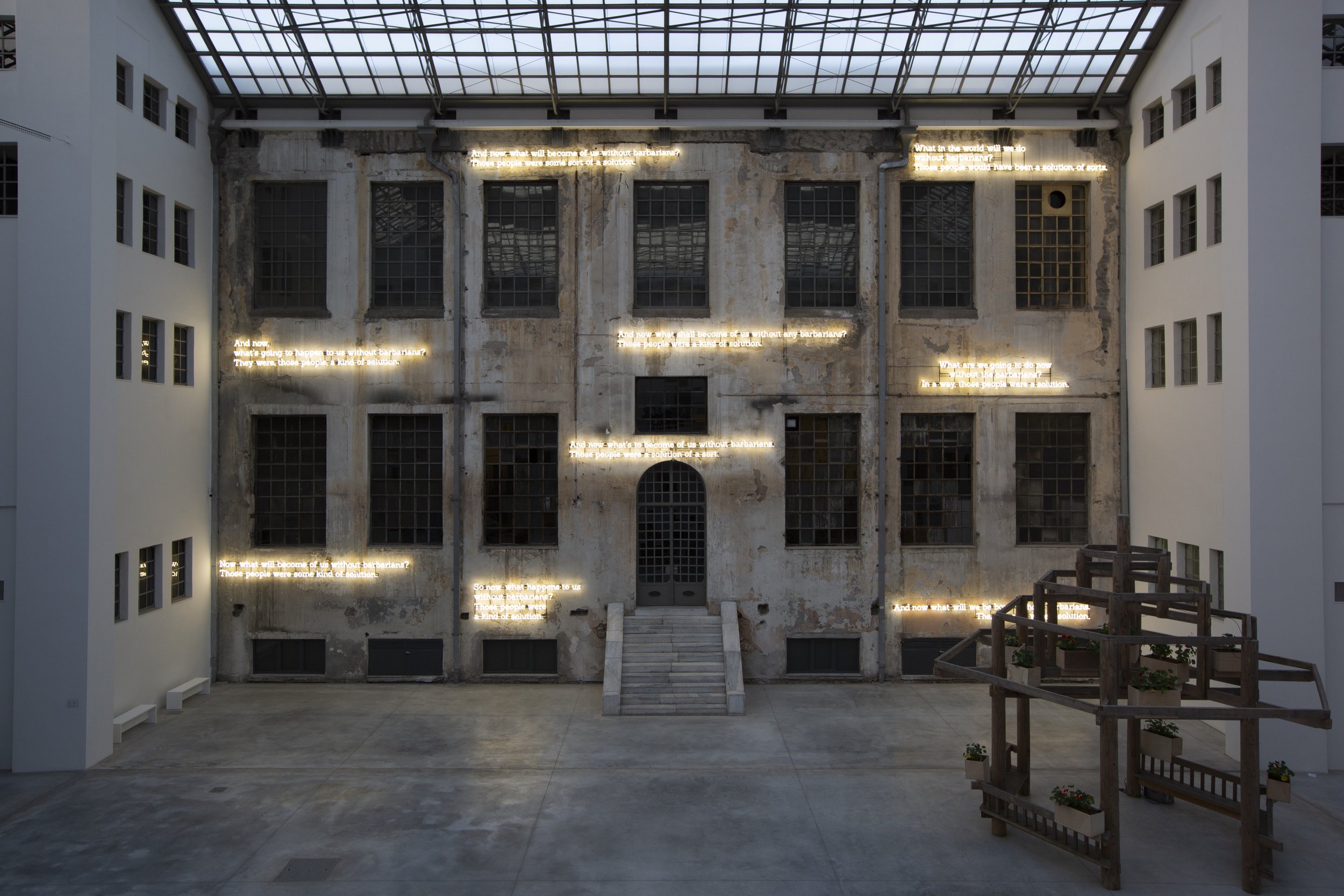GLENN LIGON - ALL OVER THE PLACE AT THE FITZWILLIAM MUSEUM
Waiting for the Barbarians_2021 originally from a factory in Athens_
What a brilliant ,disturbing show has invaded the calm decorous spaces of the Fitzwilliam Museum. Glenn Ligon has toured the galleries of this eighteenth century monument to art and culture and inserted his own ‘interventions’ - to give a fresh interpretation of what this collection, long uninterrupted, really means.
Glenn Ligon explains his title’ All Over the Place’ with his simple direct charm “ I am in so many galleries and spaces , it is remarkable.’ . In demand for his confident sweep at the stiff or rigid art anywhere,
He stands on the steps of the Fitzwilliam Museum, the monolith rises behind him and gestures at the illuminated neon writing above the massive portico.
It reads ‘Now what will become of us without barbarians?These people were some kind of solution.
So now what happens to us without barbarians? Those people were a kind of solution’
The quotations are from a poem by C.F. Cavafy, the great Greek poet, exiled for most of his life amid the glories of a faded Alexandria. Cavafy was born more than a hundred years ago but his perspective is resonant today for Glenn Ligon whose other idol is James Baldwin, the essentially American writer yet often a stranger at home and abroad - a man who expressed - like no other.the pain of being a black man
Jan Brueghel the Elder, A Stoneware Vase of Flowers, c. 1607-8, Oil on panel,
Glenn Ligon has invaded the Flower Room. It took the museum over a year to re-hang and restore its famous collection of paintings and crowd them into one space where they bloom and multiply. for dramatic effect. Most of the hundreds of floral paintings were gifts from Henry Rogers Broughton, 2nd Lord Fairhaven who had a passion for them. Glenn Ligon wanted the collection to proclaim the wealth of the donors - flowers, especially tulips. He explains his intent “ I’m aiming to alter the interpretations by doing interventions beside existing displays,” In this context the paintings act as a showcase for their rich patrons. The artist wants us to think of those who worked and suffered in their production.’These paintings are records of empire ,conquest and resource extraction as much as they are encounters with new flora and fauna or meditations on mortality and the fleetingness of life.”
Korean Moon Jars as interpreted by Glenn Ligon himself as a commentary on their role in the museum.
The jars above are a huge creative exercise made by Glenn Ligon in a kind of homage to the cool Korean moon jar in the wonderfully stocked basement at the Fitzwilliam. ‘ Mine are lumpy and rocky by comparison,‘ he announces cheerfully ‘ but I like them like that , not perfect ‘ In this gallery Glenn is intrigued by the interaction of China and Britain. During the Industrial Revolution, factories here began to copy Chinese designs for a huge home market. The porcelain on display is mostly European imitation. But Glenn has added a quirky twist. A small new glass cabinet displays the Chinese attempt to copy Josiah Wedgwood’ s work,.” I like to think they wanted to say Gotcha, we can copy too!” He notes the colours the Chinese used are far from the perfect English version, but he likes them all the more for that.
_Untitled Condition Report for Black Rage 2015_The annotations and interpretations and interventions in this work compel a close reading of the aged page and its implication for the continuing suffering of Black men in America.
Where does Degas fit in? “ I came into this room’ Glenn Ligon declared as he showed us the deep long collegiate style panelled interior‘ and I was so taken with it.” He describes the home of the Degas drawings , a panelled print room as straight out of an English Club . It immediately appealed to him and he demanded an intervention there. He noticed the lines left on the original prints and it reminded him of a quasi accident with his own copper plates, left behind at a printers and retrieved only ten years later. The lines they had made in his work were the same. So in this warmly panelled reception room there is now a Ligon/Degas encounter. Or at least I think that’s what it’s about.
Adoration of the Magi
If Glenn Ligon crowded out the Flower Room, he stripped one corridor of all but one of its exhibits. Left standing alone was the Adoration of the Magi, above. He was disappointed to see the only important black figure in this often painted scene, Balthazar, transformed into an important while man. Whilst even the page /black servant is gone. It was at this point I realised just how devoid of black subjects was the entire collection. I suddenly felt very conscious of my own whiteness
Study for Negro Sunshine Red 15_
Glenn Ligon was fascinated by this phrase taken from Gertrude Stein’s experimental writing where she uses the phrase Negro sunshine or lack of it, to describe the presence of her black friend. Glenn Ligon became so taken with this enigmatic idea he has rendered this painting, so bright and dark at once as his version of what it suggests and means.
The warm confident amusing delightful personality of Glenn Ligon is not captured in his photographic portrait. He brings us some brilliant deep and revolutionary material. It is no wonder he is All Over the Place













